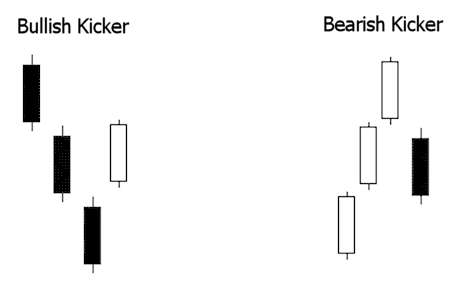There are many candlestick patterns but only a few are actually worth
knowing. Here are 10 candlestick patterns worth looking for. Remember
that these patterns are only useful when you understand what is
happening in each pattern.
They must be combined with other forms of technical
analysis to really be useful. For example, when you see one of these
patterns on the daily chart, move down to the hourly chart. Does the
hourly chart agree with your expectations on the daily chart? If so,
then the odds of a reversal increase.
The following patterns are divided into two parts: Bullish patterns
and bearish patterns. These are reversal patterns that show up after a
pullback (bullish patterns) or a rally (bearish patterns).
Bullish candlestick patterns

Ok, let's begin with the first one...
Engulfing
This is my all time favorite candlestick pattern. This pattern
consists of two candles. The first day is a narrow range candle that
closes down for the day. The sellers are still in control of the stock
but because it is a narrow range candle and volatility is low, the
sellers are not very aggressive. The second day is a wide range candle
that "engulfs" the body of the first candle and closes near the top of
the range. The buyers have overwhelmed the sellers (demand is greater
than supply). Buyers are ready to take control of this stock!
Hammer
As discussed on the previous page, the stock opened, then at some
point the sellers took control of the stock and pushed it lower. By the
end of the day, the buyers won and had enough strength to close the
stock at the top of the range. Hammers can develop after a cluster of
stop loss orders are hit. That's when professional traders come in to
grab shares at a lower price.
Harami
When you see this pattern the first thing that comes to mind is that
the momentum preceding it has stopped. On the first day you see a wide
range candle that closes near the bottom of the range. The sellers are
still in control of this stock. Then on the second day, there is only a
narrow range candle that closes up for the day. Note: Do not confuse
this pattern with the engulfing pattern. The candles are opposite!
Piercing
This is also a two-candle reversal pattern where on the first day you
see a wide range candle that closes near the bottom of the range. The
sellers are in control. On the second day you see a wide range candle
that has to close at least halfway into the prior candle. Those that
shorted the stock on first day are now sitting at a loss on the rally
that happens on the second day. This can set up a powerful reversal.
Doji
The doji is probably the most popular candlestick pattern. The stock
opens up and goes nowhere throughout the day and closes right at or near
the opening price. Quite simply, it represents indecision and causes
traders to question the current trend. This can often trigger reversals
in the opposite direction. Learn more about how to trade a doji candlestick pattern.
Bearish candlestick patterns

You'll notice that all of these bearish patterns are the opposite of
the bullish patterns. These patterns come after a rally and signify a
possible reversal just like the bullish patterns.
Ok, now it's your turn! I'll let you figure out what is happening in
each of the patterns above to cause these to be considered bearish. Look
at each candle and try to get into the minds of the traders involved in
the candle.
Kickers
There is one more pattern worthy of mention. A "kicker" is sometimes
referred to as the most powerful candlestick pattern of all.

You can see in the above graphic why this pattern is so explosive.
Like most candle patterns there is a bullish and bearish version. In
the bullish version, the stock is moving down and the last red candle
closes at the bottom of the range.
Then, on the next day, the stock gaps open above the previous days
high and close. This "shock event" forces short sellers to cover and
brings in new traders on the long side.
This is reversed in the bearish version.
For the latest updates on the stock market, visit,
http://daytradingstock-blog.blogspot.com
http://daytradingstock-blog.blogspot.com